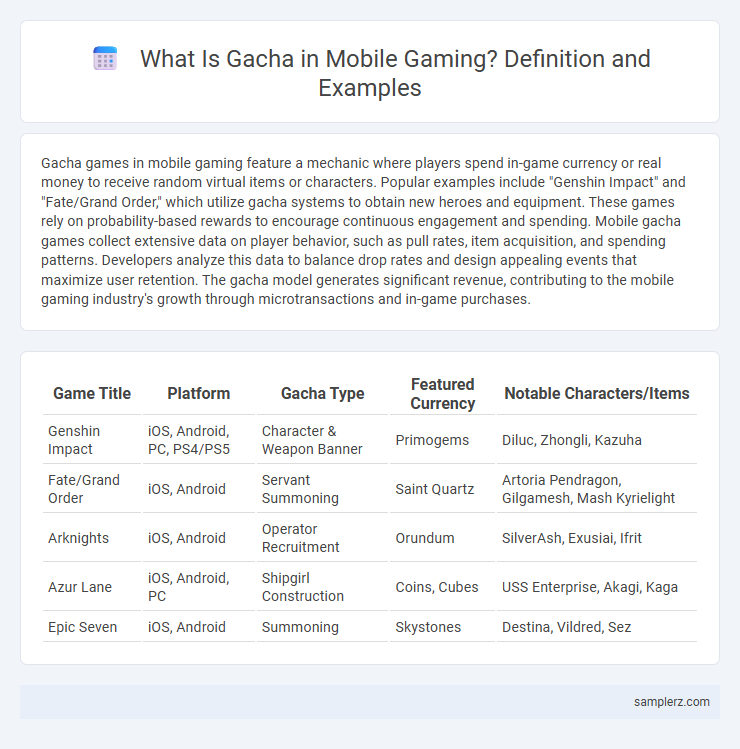Gacha games in mobile gaming feature a mechanic where players spend in-game currency or real money to receive random virtual items or characters. Popular examples include "Genshin Impact" and "Fate/Grand Order," which utilize gacha systems to obtain new heroes and equipment. These games rely on probability-based rewards to encourage continuous engagement and spending. Mobile gacha games collect extensive data on player behavior, such as pull rates, item acquisition, and spending patterns. Developers analyze this data to balance drop rates and design appealing events that maximize user retention. The gacha model generates significant revenue, contributing to the mobile gaming industry's growth through microtransactions and in-game purchases.
Table of Comparison
| Game Title | Platform | Gacha Type | Featured Currency | Notable Characters/Items |
|---|---|---|---|---|
| Genshin Impact | iOS, Android, PC, PS4/PS5 | Character & Weapon Banner | Primogems | Diluc, Zhongli, Kazuha |
| Fate/Grand Order | iOS, Android | Servant Summoning | Saint Quartz | Artoria Pendragon, Gilgamesh, Mash Kyrielight |
| Arknights | iOS, Android | Operator Recruitment | Orundum | SilverAsh, Exusiai, Ifrit |
| Azur Lane | iOS, Android, PC | Shipgirl Construction | Coins, Cubes | USS Enterprise, Akagi, Kaga |
| Epic Seven | iOS, Android | Summoning | Skystones | Destina, Vildred, Sez |
Introduction to Gacha Mechanics in Mobile Gaming
Gacha mechanics in mobile gaming involve players spending in-game currency to obtain randomized virtual items or characters, often through a lottery-like system. Popular titles like "Genshin Impact" and "Fire Emblem Heroes" utilize gacha systems to enhance player engagement by offering rare and powerful collectibles. This mechanic drives microtransactions and strategic gameplay decisions, influencing player progression and monetization models in mobile games.
Popular Mobile Games Featuring Gacha Systems
Popular mobile games featuring gacha systems include titles like Genshin Impact, Honkai Impact 3rd, and Fate/Grand Order, which attract millions of players worldwide. These games utilize randomized reward mechanics that encourage players to collect characters, weapons, and items through in-game currency or real money. The gacha system significantly contributes to player engagement and monetization strategies by offering diverse and rare rewards.
How Gacha Works: Summoning and Drops Explained
Gacha mechanics in mobile games involve summoning characters or items through randomized capsule draws, where players spend in-game currency or premium resources to receive rewards. Drop rates vary by rarity tiers, with common, rare, and ultra-rare prizes governed by predefined probabilities, often displayed in percentage formats to ensure transparency. This system leverages both chance and strategic resource management, enticing players to collect and upgrade powerful units through continuous summoning.
Iconic Gacha Examples: Fate/Grand Order
Fate/Grand Order stands as an iconic gacha mobile game, renowned for its diverse roster of historic and mythical characters, or "Servants," that players summon through a randomized capsule system. The game's strategic combat and deep narrative enhance the allure of its gacha mechanics, making each summon a pivotal moment in gameplay progression. Fate/Grand Order's success has influenced gacha design, emphasizing character rarity and storytelling to drive player engagement and monetization.
Gacha in Genshin Impact: Character and Weapon Wish Systems
Gacha mechanics in Genshin Impact involve two primary Wish systems: Character and Weapon banners, where players spend Primogems to obtain randomized rewards. Character Wishes offer heroes with unique abilities and elemental powers, while Weapon Wishes provide powerful swords, bows, polearms, and catalysts that enhance gameplay strategies. The game's pity system guarantees a 5-star item after a set number of attempts, balancing luck and reward to maintain player engagement.
Summoning Heroes: Gacha in Fire Emblem Heroes
Summoning heroes in Fire Emblem Heroes involves a gacha mechanic where players use Orbs to perform summons and obtain characters of varying rarity from the extensive Fire Emblem roster. The game features rate-up banners that increase the probability of summoning specific heroes with unique skills and abilities, enhancing team-building strategies. This hero acquisition system drives player engagement through the excitement of random rewards and collection completion.
Collecting Cards: Gacha in Yu-Gi-Oh! Duel Links
Yu-Gi-Oh! Duel Links offers an immersive gacha system where players collect rare cards through randomized packs, enhancing deck-building strategies. Key entities such as "Legendary Duelists" and "Skill Cards" drive player engagement by providing unique abilities tied to specific cards. Continuous updates introduce new cards and events, maintaining the dynamic nature of card collecting within this mobile gacha experience.
Monetization Through Gacha: Revenue Models in Mobile Games
Monetization through gacha mechanics in mobile games generates significant revenue by encouraging players to spend in-game currency on randomized items or characters, often acquired via microtransactions. Popular mobile titles like "Genshin Impact" and "Fate/Grand Order" utilize tiered rarity systems and limited-time events to drive player engagement and increase spending frequency. This revenue model capitalizes on player psychology through chance-based rewards, boosting lifetime value and creating sustained income streams for developers.
Player Experiences: Luck vs Skill in Mobile Gacha
Mobile gacha games often balance player experiences between luck and skill, where success hinges on randomized character pulls and strategic team building. Players invest in rare units through luck-based summons while relying on skillful gameplay tactics to maximize these assets in battles and events. This dynamic fosters both excitement and frustration, as chance influences access to powerful characters, while skill determines effectiveness in game progression.
Ethical Concerns and Regulation of Gacha Mechanics
Gacha mechanics in mobile gaming often mimic gambling by encouraging players to spend real money on randomized rewards, raising ethical concerns about addiction and exploitation of vulnerable users. Regulatory bodies in countries like Japan and South Korea have imposed transparency requirements and spending limits to protect players, reflecting growing scrutiny over these practices. Developers face increasing pressure to balance monetization with responsible game design to avoid legal repercussions and maintain player trust.

example of gacha in mobile Infographic
 samplerz.com
samplerz.com